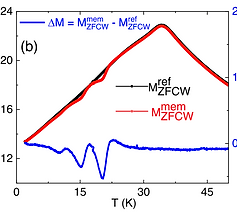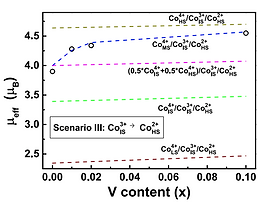Research Interests:
Magnetism and spin-dependent transport in nanoscale structures
-
Magnetic thin films and multilayers
-
Quantum Materials (Skyrmion, Topological Insulator, Altermagnet etc.)
-
Heusler Alloys
-
Multifunctional Oxides
Stability of Isolated Magnetic Skyrmions under varying Material and External Parameters:
Magnetic skyrmions are nanoscale vortex-like spin textures that emerge in certain magnetic materials due to chiral interactions. They are topologically protected, which makes them remarkably stable against perturbations, and they can be manipulated with currents much smaller than those required for conventional magnetic domains. These unique properties make skyrmions highly attractive for next-generation spintronic applications such as ultra-dense memory, ultrafast logic devices, and highspeed information processing. The isolation of small-sized magnetic skyrmions depends on several factors such as the exchange stiffness of the material, the strength of DM interaction, the applied external magnetic field, etc. Hosting of stable small-sized skyrmions above room temperature is crucial for practical applications. Through micromagnetic simulations, several probable magnetic systems can be easily scanned to select the best material systems in terms of skyrmion stability under temperature and magnetic field variations. Our investigations suggest that the smallest skyrmions are stabilized in the CoZnMn system at few hundred mT of external field at room temperature, which is very promising for technological applications.
M.Sc. thesis (A. Mishra)
Epitaxial Magnetic Thin Films with Perpendicular Magnetic Anisotropy:
Magnetic thin films with perpendicular magnetic anisotropy (PMA) at room temperature have garnered considerable interest due to their potential applications in nanoscale spintronics devices for information storage and processing. Theoretical predictions of a large PMA constant, a large Curie temperature, a low damping constant and a high spin polarisation makes Mn3Ge a suitable candidate for material electrodes in magnetic tunnel junctions. The Mn-Ge films prepared by DC magnetron sputtering on Ir/Cr buffered MgO(100) grow epitaxially, having c-axis of the tetragonal (D022) unit cell pointing out of the film plane. The composition has a drastic impact on the magnetic properties of these films. Mn77.5Ge22.5 films close to stoichiometric Mn3Ge exhibit perpendicular magnetic anisotropy with good magnetic texture (0.04) and squareness (0.87). However, two extreme compositions show high coercivity but very low magnetization. The reason for low magnetization can be ascribed to the substitution of excess Mn into Ge sites and the formation of secondary nonmagnetic phases for films with high and low Mn content, respectively. Nevertheless, at room temperature, the measured values of saturation magnetization, coercivity and anisotropy field for the epitaxial Mn77.5Ge22.5 films are 90 emu/cc, 2.86 T and 9.6 T, respectively. Furthermore, the effect of epitaxial strain on the phase formation and magnetic properties is also investigated. Mn-Ge films grown on different single-crystal substrates also exhibit c-axis textured growth and perpendicular magnetic anisotropy with substantial coercivity.
S. Dash et al., J. Phys. D: Appl. Phys 51, 255002 (2018)
Structural Stability and Emergent Magnetic Properties of Novel Mn-based Heusler Alloys:
Heusler alloys with a general formula X2YZ (X and Y: transition metals, Z: main group element) have become a topic of tremendous interest due to their diverse range of tunable physical properties. The goal is to shed some light on the discrepancy observed between the theoretical prediction and experimental observation regarding the crystal structure and the corresponding magnetic ground state of Mn2FeAl alloys. A thorough investigation was carried out on the structural, magnetic, and thermodynamic properties of a phase pure arc melted alloy of Heusler composition (i.e. Mn2FeAl) stabilizing in a geometrically frustrated cubic (β-Mn) structure with an antiferromagnetic ordering (Néel transition, TN ≈ 42 K). Our theoretical electronic structure calculations, in excellent agreement with our experimental observation, reveal that for expansion of the lattice volume, β-Mn structure was preferable in total energy for the Mn2FeAl alloy. A first-ever report has been made on the theoretically predicted lowest ground state configuration for Mn2FeAl with a β-Mn structure and the experimental realisation of spin glass features in this geometrically frustrated antiferromagnet. Further extending our investigation, we could confirm the signature of spin glass behaviour in Mn3-xFe1+x+yAl1-y, by the observations of bifurcation of the zero-field-cooled and field-cooled magnetization curves, field dependent shift of the irreversibility temperature, unidirectional exchange bias effect, exponential decay of the temperature variation of remanence and coercivity, frequency dependent shift of the spin glass freezing temperature as per the dynamic scaling laws, magnetic relaxation and magnetic memory effect.
S. Dash et al., J. Magn. Magn. Mater. 513, 167205 (2020)
A. K. Khorwal et. al., J. Magn. Magn. Mater, 546, 168752 (2022)
A. K. Khorwal et. al., J. Chem. Phys. 160, 114705 (2024)
S. Saha et al., Phys. Status Solidi Rapid Research Letters in press (2025)
Spin-Phonons Coupling in Strongly Correlated Systems:
The SmFeO3 compounds are found to crystallise in an orthorhombic structure with space group “Pnma” and no structural phase transitions is being noticed in the investigated temperature range (300-500 K). The increase in the room temperature field-dependent magnetization due to the Bi doping suggests the contribution of rare earth-Fe ion interaction to the magnetic moment. However, with co-doping of Bi and Mn, a decrease in magnetization and a considerable increase in coercivity is observed, which corresponds to the dilution of Fe3+-Fe3+ interactions due to the presence of Mn3+ ions. Magnetic measurements reveal the weak ferromagnetic-paramagnetic transition at 620 K. Temperature variation of phonon modes investigated using Raman spectroscopy in the range of 300-800 K reveals that Ag (3) phonon mode related to FeO6 vibrations manifests anomalous behaviour below magnetic transition temperature, which is attributed to spin-phonon coupling (using the mean-field approximation method). The strength of spin-phonon coupling is found to be 1.7 cm-1 and is comparable with other compounds. The obtained valence states from XPS analysis of all the elements of the sample are in excellent agreement with the expected values.
Nancy et al., J. Magn. Magn. Mater. 513, 167094 (2020)
Magnetic interactions of Ferromagnetic Cobaltites:
La0.5Sr0.5CoO3−δ system displaying coexistence of metallicity and ferromagnetism, and the interplay between distinct spin states of Co ions has gained significant attention from the fundamental as well as the applications point of view. The increase of lattice parameters/volume with increasing V5+ content in rhombohedrally crystallized samples is attributed to the presence of Co2+ ions . The presence of Co2+ ions and the reduction of Co3+ ion concentration with V substitution is verified from the results of core-level photoemission spectra of Co. Detailed magnetic measurements show an increase in Curie temperature, effective magnetic moment, soft magnetic nature and suggesting strengthening of underlying magnetic interactions. As a result of multiple oxidation states of Co ions and the delocalization of electrons, rise in the conductivity is noticed. Such enhancement in the conductivity and ferromagnetic ordering temperature, simultaneously, with V doping implies a strong coupling between spin and charge degrees of freedom. To understand the underlying mechanism more clearly, different possible scenarios have been discussed. The most appropriate scenario i.e., the conversion of Co3+ ions into Co2+ ions and admixture of Co4+ ion spin states with V5+ doping was found to be consistent with all the experimental observations.
Nancy et al., J. Magn. Magn. Mater. 530, 167851 (2021)










